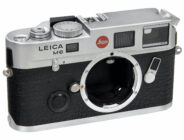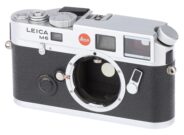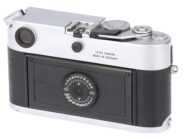Announced
Production status
Order No.
System
Leica M system cameras
- Leica M (Typ 240)
- Leica M (Typ 262)
- Leica M Monochrom
- Leica M Monochrom (Typ 246)
- Leica M-A (Typ 127)
- Leica M-D (Typ 262)
- Leica M-E (Typ 220)
- Leica M-E (Typ 240)
- Leica M-P (Typ 240)
- Leica M1
- Leica M10
- Leica M10 Monochrom
- Leica M10-D
- Leica M10-P
- Leica M10-R
- Leica M11
- Leica M11 Monochrom
- Leica M11-P
- Leica M2
- Leica M3
- Leica M4
- Leica M4-2
- Leica M4-P
- Leica M5
- Leica M6
- Leica M6 (Typ 2248)
- Leica M6 Panda
- Leica M6 Titanium
- Leica M6 TTL
- Leica M6J
- Leica M7
- Leica M8
- Leica M8.2
- Leica M9
- Leica M9-P
- Leica MD
- Leica MD-2
- Leica MDa
- Leica MP
- Leica MP Original
Leica M6 TTL
35mm MF film rangefinder camera • Discontinued
Specification
| Format: | |
| 35mm full frame | |
Film type: | 135 cartridge-loaded film |
| Leica M [27.8mm] | |
| Shutter: | |
Type: | Focal-plane |
Model: | Mechanical |
Speeds: | 1 - 1/1000 + B |
| Exposure: | |
Exposure metering: | Through-the-lens (TTL), stop-down |
Exposure modes: | Manual |
| Rangefinder and Viewfinder: | |
Rangefinder: | Built-in, combined with viewfinder |
Viewfinder: | Built-in, combined with rangefinder |
Finder magnification: | 0.58x |
| 0.72x | |
| 0.85x | |
Actual rangefinder base: | 69.25mm |
Effective rangefinder base: | 40.17mm - with 0.58x |
| 49.86mm - with 0.72x | |
| 58.86mm - with 0.85x | |
Bright-line frames: | 28mm & 90mm, 35mm, 50mm & 75mm - with 0.58x |
| 28mm & 90mm, 35mm & 135mm, 50mm & 75mm - with 0.72x | |
| 35mm & 135mm, 50mm & 75mm, 90mm - with 0.85x | |
Parallax compensation: | Yes |
| Physical characteristics: | |
Weight: | 560g |
Dimensions: | 138x79.5x38mm |
| Accessories: | |
Body cap: | 14195 |
| 14397 |
Manufacturer description #1
The LEICA M6 TTL follows the principle of classic master-works: concentration on the essential.
LEICA M6 TTL - For people who focus on creativity.
Since Oskar Bamack developed the original Leica camera in 1914, Leica has pursued a simple yet great idea. The idea that it is the creative power of the photographer that determines the actual quality of a picture and makes a perfection composition of shapes, light and colour. This philosophy is reflected completely in the LEICA M6 TTL, which is the epitome of classic, timeless elegance and a great awareness of style. It unifies high-precision technology and the optical perfection of the M lens. The LEICA M6 TTL fascinates because it offers the experience of original, creative photography by eschewing some things which although, perhaps, technically possible would only place a restriction on creativity. After all, it is the photographer who should be master of the medium and not vice versa.
Proximity to what’s happening
How are extraordinary, moving pictures taken? Through the harmonious interaction of the photographer and the camera. And through the close proximity to what’s happening. When it comes to spontaneous and inconspicuous reactions, the LEICA M6 TTL is irreplaceable: it enables the photographer to get in close. Using the LEICA M6 TTL, you don’t have to worry about the distance between you and your subject. The camera remains unnoticed and itself becomes part of the setting. The personality of the M photographer is characterised by sensitivity and an intuitive grasp of how to act discretely and with restraint. He or she has a good power of observation and is always in command of the situation. For such people, the LEICA M6 TTL – with wide-opening lenses distinguished by excellent imaging, as well as the new TTL flash exposure meter – opens up great new opportunities for creative photography in the immediate vicinity of the subject.
The right setting for your subject
The viewfinder of the LEICA M6 clearly displays all the information you need for total control of focusing and exposure metering. Unsurpassed precision gives you the assurance of immediately being able to find the correct settings in any situation. Even under difficult light conditions.
The very first look through the combined range- and viewfinder of the LEICA M6 TTL is already impressive because of its bright, crisp and contrasty image that is always of the same size. The surroundings of your subject are always clearly visible: a significant advantage for maintaining an overview of the action, especially with fast-moving subjects. When a lens is attached to the camera, a bright- line frame that corresponds to the focal length of that lens is automatically activated in the viewfinder. These bright and clearly visible brightline frames show the area of the subject covered by the respective lenses. But the different brightline frames can also be brought into view manually, without changing lenses, by means of the frame selector lever. So that you can quickly and conveniently determine which lens will give you the most effective cropping of your subject.
Pinpoint focusing
Experts consider the long-base rangefinder of the LEICA M6 to be a masterpiece. While the focal length and the aperture of the lens being used determine the measuring base in a single lens reflex system, on the LEICA M6 it always remains unchanged – regardless of the lens that happens to be attached. This permits pinpoint-accurate focusing even with low-contrast subjects that no other 35 mm camera can provide. With short focal length lenses, the focusing accuracy of the LEICA M6 is far greater than that of a single lens reflex camera. With the combination split-image and coincidence rangefinder, you can place pinpoint sharpness exactly where you want it. Quickly and effectively. Even under extremely poor light conditions.
The alternative with the larger viewfinder image
With the LEICA M6 you have the choice of two viewfinder options: one with the accustomed 0.72x magnification – and now a new one with an 0.85x viewfinder magnification. If you frequently use lenses with longer focal lengths, you will be especially pleased with this new version.
The comparison makes it easy to understand: Not only the subject itself, but also the brightline frames and the rangefinder field that are visible in the viewfinder of the LEICA M6 0.85x are enlarged by nearly 20%. And the expansion of the effective measuring base of the rangefinder from 49.9 mm to 59.1 mm increased the focusing accuracy even further. An noticeable plus when lenses with large apertures or with long focal lengths are being used.
Perfect results with selective exposure metering
Back lighting, grazing lateral light, spot lighting. Outstanding photographs often involve unusual lighting situations, and that is precisely when accurate exposure is of decisive importance. Selective through-the-lens exposure metering with the LEICA M6 gives you the assurance of rendering every subject in the right light. A silicon photo-diode positioned behind a collector lens measures the light reflected by a white spot on the focal plane shutter curtain. Thanks to its extraordinarily high sensitivity, the built-in exposure meter of the LEICA M6 measures the light conditions of any situation with great accuracy – even in extremely poor light. The glow of a single candle already suffices.
Easy exposure setting
The viewfinder provides you with an overview of the necessary indicators for setting the exposure. The exposure meter is activated by gently depressing the shutter release button, so that you can conveniently use the light balance to set the right combination of shutter speed and aperture: Two triangular light emitting diodes indicate the direction in which you must turn the aperture ring or the shutter speed dial. A round light emitting diode in the center lights up to signal when the correct setting is made.
New: TTL flash exposure metering with the LEICA M6
Metered flash exposures with an M-camera? But of course, and even better with the new LEICA M6 TTL! In combination with the new LEICA SF 20 flash unit or other SCA-3000-compatible flash units, flash exposures with an M-camera are, for the first time, metered where the picture is actually recorded: on the surface of the film.
LEICA M cameras have long distinguished themselves for their superior focusing in poor light and in low contrast situations. But even when you use ultra high speed lenses, there are always situations when you need supplementary lighting. The new LEICA M6 TTL optimally combines the advantages of super-imposed image rangefinding for accurate focusing in low ambient light with the precise control of the flash exposure by means of TTL flash exposure metering.
Simple and precise: TTL flash exposure control
Fill-in flash in low light situations? Placing accents in the foreground with light? Record every subject in darkened rooms with confidence? With the TTL flash exposure control of the new LEICA M6 TTL you have the best prerequisite for creating impressive photographs as you envision them. Confidently. Even in difficult light conditions. Because vibration is extremely low when the shutter is released, you obtain evenly exposed photographs with the LEICA M6 TTL, even with the longer synchronized flash exposure times, and the natural illumination of the background blends harmoniously with the foreground that has been enhanced with fill-in flash. And deliberate control of the flash output of the LEICA SF 20 – or of other system- compatible flash units – creates additional creative opportunities for you. Especially in situations where you must add fill-in flash in spite of high speed lenses, the advantages of the super-imposed image rangefinder and TTL flash exposure metering on the new LEICA M6 TTL become clearly evident.
Paragon of precision and dependability
Selected high-grade materials, extremely tight tolerances and strict quality control at every step of manufacture of the LEICA M6 TTL ensure flawless precision, the highest dependability and decades-long value retention.
Robust mechanisms, whisper-quiet shutter release
Impressive scenes can only be captured if the camera is ready for action at all times. Especially in unforeseen situations. The new LEICA M6 TTL offers the best premises for this purpose. It is small, handy and lightweight. And it can be made ready for shooting quickly, without attracting much attention. Its controls are arranged ergonomically and they can be operated while wearing gloves (which is practical, for instance, while skiing). Thanks to a tactile marking, lenses can be changed quite instinctively, even in the dark.
And you are likely to be especially pleased with the whisper-quiet sound of the LEICA M6 shutter when you need to take pictures inconspicuously. The hinged mirror that flips up and the spring-loaded iris diaphragm that are needed for single lens reflex camera operation are absent. This, furthermore, allows the shutter to be released without vibrations, enabling you to take photographs with considerably slower shutter speeds while still holding the camera by hand. With the real-time shutter release of the LEICA M6 – which is nearly 10 times as fast as that of a single lens reflex camera – you can always capture that “decisive moment” in real time. And since you advance the film manually, you don’t have to endure the disturbing buzz of the automatic film advance after you release the shutter.
Quality “made by Leica”
With a LEICA M6 you can immediately sense the exquisite precision with which it was manufactured. And with the selection of raw materials, only the very best will suffice. When you hold the new LEICA M6 TTL in your hands for the first time, it will have already passed its toughest inspections and tests.
- For instance: longevity tests. Even after you have exposed several thousand films with your LEICA M6 – the shutter will operate as accurately and reliably as it did on the first day.
- In vibration tests, the LEICA M6 has to prove its extraordinary shock- and impact resistance.
- In climate tests, the LEICA M6 is exposed to repeated extreme temperature fluctuations, after which it must still function flawlessly.
The “made by Leica” standard of quality is present in all the details of this camera. For example, the LEICA M6 is not merely lacquered, instead it is plated with black or silver chrome in accordance with a proprietary process developed by Leica especially for this purpose. This robust camera will not let you down. The camera body as well as all LEICA M lenses were built for heavy duty use.
Manufacturer description #2
Plus points of the LEICA M system at a glance
- The LEICA M system stands for reliable performance in all situations, for value retention and for longevity.
- The combined range- and viewfinder is always bright and brilliant and it clearly shows the surroundings of the subject. Even dynamic subjects can quickly be framed in the picture.
- The long-base rangefinder with its constant measuring base permits fast pinpoint focusing even in low contrast situations.
- Selective through-the-lens exposure metering guarantees accurate results even in poor light conditions.
- The new TTL flash exposure metering feature expands the possibilities of LEICA M photography and it makes flash photography more accurate and convenient.
- The mechanical shutter release is gentle and quiet, and it is vibration-free: ideal qualities for inconspicuous photography.
- There is no delay in the release of the shutter, so that “decisive moments” can be captured in real time.
- The robust precision mechanisms operate extremely reliable, even under the harshest conditions.
- With its handy shape, the LEICA M6 is an ideal companion – for both serious amateur- and professional photographers.
- Leica offers a large assortment of high performance lenses for the LEICA M6, with focal lengths ranging fro 21 to 135 mm and speeds as fast as f/1. Excellent sharpness, extraordinarily high contrast performance and strictly neutral color rendition are their outstanding characteristics.
- Leica customer service and more than 100 Leica representatives all over the world, as well as a large network of authorized Leica dealers ensure qualified Leica service most anywhere.
Manufacturer description #3
06 - 08/2000 - New at photokina: Leica M6 TTL 0.58
The new Leica M6 TTL with 0.58x viewfinder magnification is a useful alternative to the two successful models of the rangefinder system camera model with 0.72x and 0.85x viewfinder magnification. This version is particularly suitable for wide-angle photography and for eyeglass wearers. With the development of this new wide-angle version, Leica Camera AG, Solms, is responding to the increasing use of short focal length lenses on professional rangefinder cameras.
Users of a Leica M6 TTL 0.58, particularly those who wear eyeglasses, will benefit from a clearer view of the 28mm and 35mm frames. In addition, more of the area surrounding the subject can be seen at all focal lengths. This is a particular advantage when capturing moving scenes, as it allows the photographer to react immediately to changes both inside and outside of the picture and define the best picture area just before releasing the shutter.
The viewfinder frames are indicated in pairs for the focal lengths 28 and 90mm and 50 and 75 mm. The frame for the commonly used focal length 35mm, on the other hand, is indicated separately on the new Leica M6 TTL 0.58. There is no frame for the telephoto focal length 135mm, as there is no point in using the special wide-angle version of the Leica M6 for the longest focal length of the Leica rangefinder system.
All the proven advantages of the high-precision rangefinder system have been incorporated. Even when using the wide-angle finder of the new Leica M6 TTL 0.58, perfect focusing is possible under the most difficult light conditions with a high-performance lens such as the Leica Noctilux-M f/1/50 mm or the Leica Apo-Summicron-M f/2/90 mm ASPH.
Like its sisters, the new Leica M6 TTL 0.58 is available with either professional black or classic silver chrome finish. It is also possible to retrofit already owned Leica M6 TTL cameras with the new viewfinder with 0.58x magnification on request.
Special editions (13)
- Leica M6 TTL Green (300 units) - 2000
- Leica M6 TTL Titanium (1000 units) - December 2001
- Leica M6 TTL "Die letzten 999 M6" (999 units) - January 2003
- Leica M6 TTL "Dragon 2000" (500 units) - 2000
- Leica M6 TTL "HANSA" (100 units) - September 2001
- Leica M6 TTL "ICS" (200 units) - February 2000
- Leica M6 TTL "Kanto" (100 units) - 2000
- Leica M6 TTL "LHSA Special Edition" (1150 units) - 2000
- Leica M6 TTL "Millennium" (2000 units) - 2000
- Leica M6 TTL "NSH" (400 units) - 2000
- Leica M6 TTL "Sheikh Saud Bin Mohd. Al-Thani" (16 units) - 2001
- Leica M6 TTL "Test the Best" (40 units) - 2000
- Leica M6 TTL "Øresundsbron" (150 units) - 2000
Similar cameras (13)
35mm full frame • Manual focus • Film • Rangefinder • Leica M mount
| Model | Shutter | Metering | Modes | Year |
|---|---|---|---|---|
| Cosina Voigtlander BESSA-R2 | M, 1/2000 | TTL • WA | M | 2002 ● |
| Cosina Voigtlander BESSA-R2A | E, 1/2000 | TTL • WA | AM | 2004 ● |
| Cosina Voigtlander BESSA-R2M | M, 1/2000 | TTL • WA | M | 2006 ● |
| Cosina Voigtlander BESSA-R3A | E, 1/2000 | TTL • WA | AM | 2004 ● |
| Cosina Voigtlander BESSA-R3M | M, 1/2000 | TTL • WA | M | 2006 ● |
| Cosina Voigtlander BESSA-R4A | E, 1/2000 | TTL • WA | AM | 2006 ● |
| Cosina Voigtlander BESSA-R4M | M, 1/2000 | TTL • WA | M | 2006 ● |
| Cosina Voigtlander BESSA-T | M, 1/2000 | TTL • WA | M | 2001 ● |
| Konica HEXAR RF | E, 1/4000 | TTL • WA | AM | 1999 ● |
| Leica CL aka LEITZ minolta CL |
M, 1/1000 | TTL • WA | M | 1973 ● |
| Minolta CLE | E, 1/1000 | TTL • WA | AM | 1980 ● |
| Rollei 35 RF | M, 1/2000 | TTL • WA | M | 2002 ● |
| Zeiss Ikon | E, 1/2000 | TTL • WA | AM | 2004 ● |







